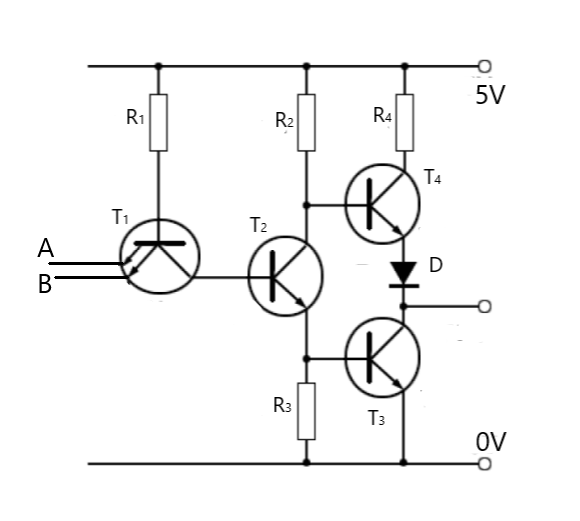
Draw the circuit diagram of TTL NAND gate and explain its working with the help of a truth table.
Answer
528.6k+ views
Hint: Recall that NAND gate allows is only 0 when both inputs are equal to 1. A TTL NAND gate logic circuit has at least four bi polar junction transistors in which the input (transistor which receives input) has two emitters. The output is taken between the emitter and collector of two different transistors.
Complete answer:

The above diagram is the circuit diagram of a TTL NAND gate.
From the diagram, we shall explain the working. Now, as seen, the transistor \[{T_1}\] has two emitters to allow two inputs into the transistor. Now, as connected the base voltage will be at 5V. if both inputs are logic 1 (usually means about 5V too), the potential difference across base and emitter would be zero or nearly. Hence, no current will flow and the transistor is turned off. So, the collector voltage would also be equal to about 5V. Hence, this potential can drive current through the emitter of the transistor \[{T_2}\]. This then will allow the collector voltage of the transistor \[{T_2}\] to fall.
Now due to the current flowing through the emitter, there would be a voltage drop across the resistor \[{R_3}\]. The desired voltage drop would be about \[0.7V\]. As seen, this is the input of the transistor \[{T_3}\]. Hence, the transistor is turned on. Due to saturation, the collector voltage will fall to about \[0.2V\] which is a logic 0. A
For the transistor \[{T_4}\], observe that the emitter voltage is made up of the entire voltage of the transistor \[{T_3}\] plus the voltage drop across the diode D about \[0.7V\]. Hence the emitter potential would be \[0.7 + 0.2 = 0.9V\]. Now the base voltage of the transistor \[{T_4}\], would be the voltage across the base-emitter of \[{T_3}\] and the voltage of the entire transistor (i.e.) voltage across emitter-collector. This would also be equal to about \[0.9V\]. Hence the emitter voltage and the collector voltage are equal. So the transistor \[{T_4}\] will be turned off too. So the output is zero when both inputs are 1.
Note:
For clarity, note that logic circuits are made such that the transistors will work in saturation mode. Hence, in the explanation above, note that when we say current is flowing, we imply that saturation current is flowing.
Complete answer:

The above diagram is the circuit diagram of a TTL NAND gate.
From the diagram, we shall explain the working. Now, as seen, the transistor \[{T_1}\] has two emitters to allow two inputs into the transistor. Now, as connected the base voltage will be at 5V. if both inputs are logic 1 (usually means about 5V too), the potential difference across base and emitter would be zero or nearly. Hence, no current will flow and the transistor is turned off. So, the collector voltage would also be equal to about 5V. Hence, this potential can drive current through the emitter of the transistor \[{T_2}\]. This then will allow the collector voltage of the transistor \[{T_2}\] to fall.
Now due to the current flowing through the emitter, there would be a voltage drop across the resistor \[{R_3}\]. The desired voltage drop would be about \[0.7V\]. As seen, this is the input of the transistor \[{T_3}\]. Hence, the transistor is turned on. Due to saturation, the collector voltage will fall to about \[0.2V\] which is a logic 0. A
For the transistor \[{T_4}\], observe that the emitter voltage is made up of the entire voltage of the transistor \[{T_3}\] plus the voltage drop across the diode D about \[0.7V\]. Hence the emitter potential would be \[0.7 + 0.2 = 0.9V\]. Now the base voltage of the transistor \[{T_4}\], would be the voltage across the base-emitter of \[{T_3}\] and the voltage of the entire transistor (i.e.) voltage across emitter-collector. This would also be equal to about \[0.9V\]. Hence the emitter voltage and the collector voltage are equal. So the transistor \[{T_4}\] will be turned off too. So the output is zero when both inputs are 1.
| A | B | Y |
| 0 | 0 | 1 |
| 0 | 1 | 1 |
| 1 | 0 | 1 |
| 1 | 1 | 0 |
Note:
For clarity, note that logic circuits are made such that the transistors will work in saturation mode. Hence, in the explanation above, note that when we say current is flowing, we imply that saturation current is flowing.
Recently Updated Pages
Master Class 12 Economics: Engaging Questions & Answers for Success

Master Class 12 Maths: Engaging Questions & Answers for Success

Master Class 12 Biology: Engaging Questions & Answers for Success

Master Class 12 Physics: Engaging Questions & Answers for Success

Basicity of sulphurous acid and sulphuric acid are

Master Class 12 Business Studies: Engaging Questions & Answers for Success

Trending doubts
What are the major means of transport Explain each class 12 social science CBSE

Which are the Top 10 Largest Countries of the World?

Draw a labelled sketch of the human eye class 12 physics CBSE

How much time does it take to bleed after eating p class 12 biology CBSE

Explain sex determination in humans with line diag class 12 biology CBSE

Differentiate between homogeneous and heterogeneous class 12 chemistry CBSE




